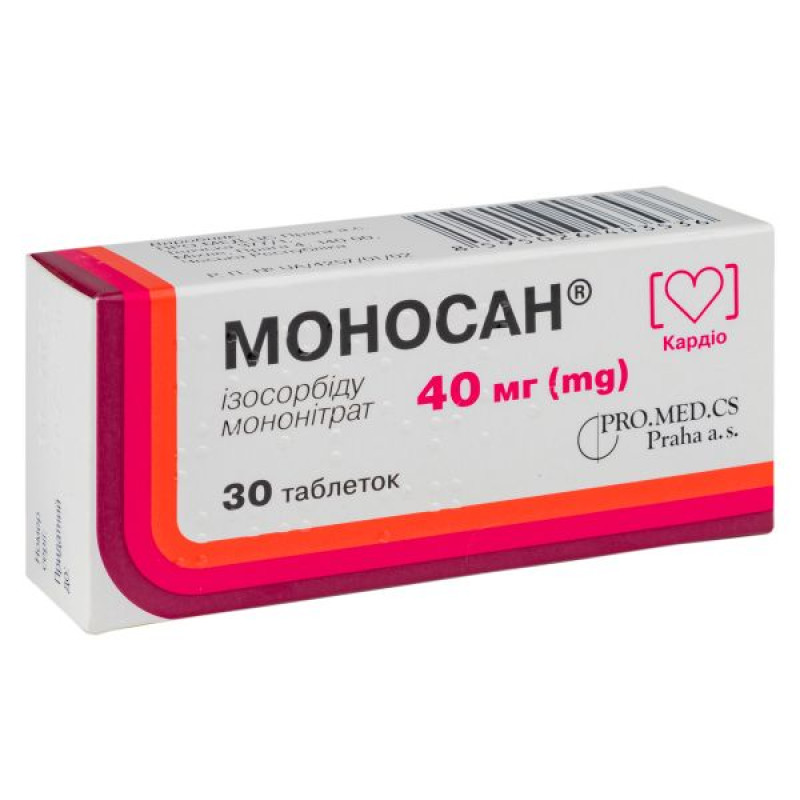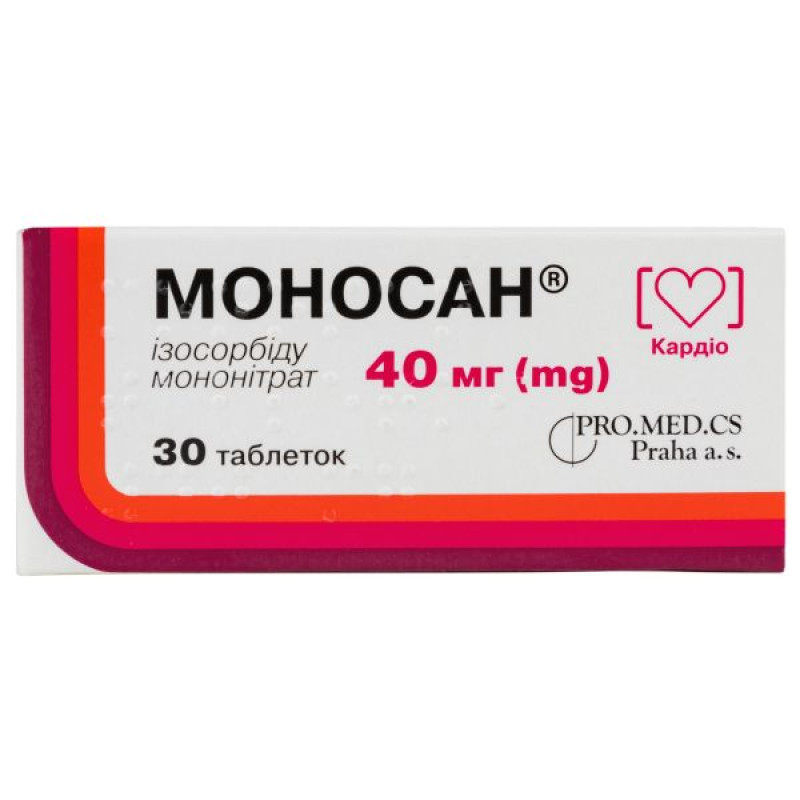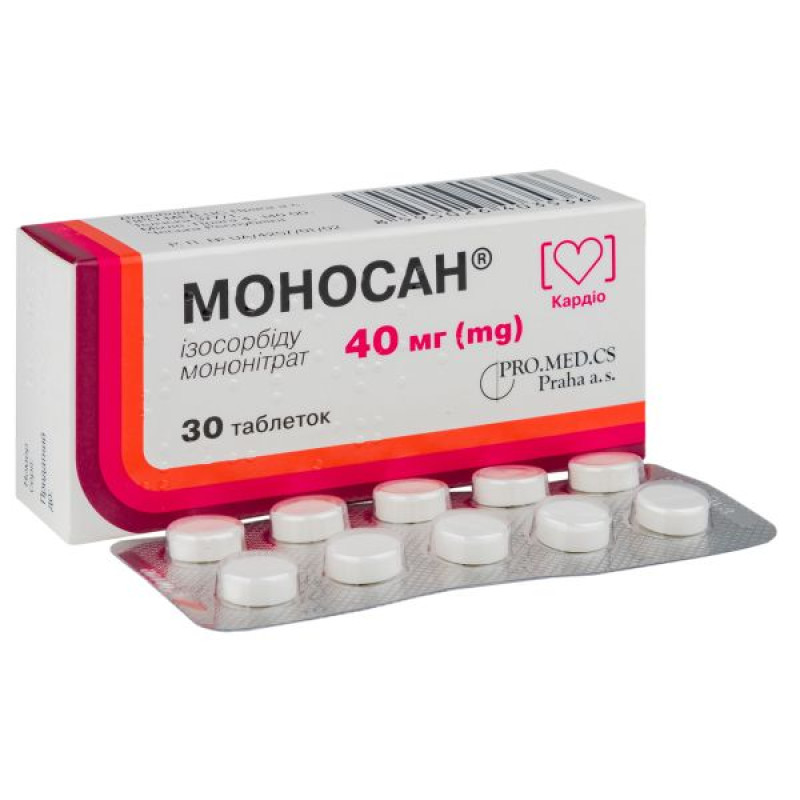Monosan tablets 40 mg No. 30

Pharmacological properties
Monosan (isosorbide-5-mononitrate) is an organic nitrate, a metabolite of isosorbide dinitrate.
Causes relaxation of vascular smooth muscle and vasodilation due to the formation of nitric oxide. The effect of isosorbide dinitrate develops faster than that of isosorbide mononitrate.
Isosorbide mononitrate simultaneously dilates peripheral veins and arteries, which leads to an increase in the capacity of venous vessels and a decrease in venous return to the heart, and, as a result, to a decrease in the end-diastolic pressure of the ventricles and preload. The effect on arterial vessels leads to a decrease in OPSS (afterload), facilitating the work of the heart. The simultaneous effect on pre- and afterload leads to a decrease in the need for myocardial oxygen. In addition, isosorbide mononitrate causes a redistribution of blood flow towards the subendocardial regions with a partial decrease in coronary blood flow due to the presence of atherosclerotic plaques. The dilation caused by nitrates improves perfusion of post-stenotic areas of the myocardium. Nitrates eliminate eccentric coronary stenosis, reducing veno-spasm, and improve hemodynamics at rest and during exercise in patients with congestive heart failure. By reducing the need for oxygen and increasing its delivery, the area of damaged myocardium is limited. Isosorbide mononitrate affects other organs and systems: it relaxes the muscles of the bronchi, gastrointestinal tract, biliary and urinary tracts. The effect of the drug develops after 20 minutes and lasts for 8 hours.
Monosan somewhat inhibits platelet aggregation and reduces intraplatelet thromboxane synthesis.
The drug increases exercise tolerance in patients with coronary artery disease.
Pharmacokinetics. After oral administration of isosorbide mononitrate is completely absorbed. C max in blood plasma is reached 1 hour after administration. During the first passage through the liver, isosorbide-5-mononitrate is not subjected to biological transformation, does not bind to blood plasma proteins. T ½ of the drug is 4-5 hours. Heart or renal failure do not affect the pharmacokinetics of isosorbide-5-mononitrate.
Indication
Prevention of angina attacks, congestive heart failure.
Application
The drug is taken orally before meals, without chewing and with sufficient liquid.
The dose and frequency of administration are set individually by the doctor. In order to achieve the maximum therapeutic effect, individual dosage of the drug is recommended depending on the patient's condition, his reaction to the drug and tolerability.
Treatment is started with low doses, which are increased as needed. In most cases, 20 mg twice a day or 40 mg twice a day in the morning and afternoon (for example, at 8:00 and 15:00) are prescribed.
In order to prevent the development of tolerance to nitrates (with any dosage regimen), it is recommended to take the second tablet no earlier than 8 hours after taking the first.
When treating angina with frequent nocturnal attacks, the drug should be used in the morning and immediately before bedtime.
Hemodynamic monitoring is important for determining individual dosage.
The daily dose, depending on the severity of the disease, can reach 160 mg (maximum daily dose), divided into 3 doses.
Contraindication
Hypersensitivity to the active substance or any component of the drug; acute circulatory failure, severe arterial hypotension or collapse, shock; acute myocardial infarction with low left ventricular filling pressure; severe anemia; recent traumatic brain injury or cerebral hemorrhage; glaucoma; simultaneous use with sildenafil and other phosphodiesterase inhibitors; pregnancy and breastfeeding; children's age.Side effects
Often - headache at the beginning of treatment, as well as when increasing the dose of the drug, which gradually decreases over several days; infrequently - dizziness, arterial hypotension, motor anxiety, inattention, drowsiness and weakness, orthostatic collapse, tachycardia, bradycardia, methemoglobinemia; rarely - development of glaucoma, increased intracranial pressure, change in the speed of mental reactions.
Sometimes, with a sharp decrease in blood pressure, paradoxical nitrate reactions are possible - an increase in the severity of angina attacks.
In patients prone to allergic reactions, skin rashes, itching, skin hyperemia are possible; in some cases, exfoliative dermatitis. Tolerance often develops.
Rarely - dry mouth, nausea, vomiting, dilation of skin vessels with redness, general weakness, fatigue.
Reflex tachycardia and symptomatic palpitations may occur as a result of the sympathomimetic effect due to the decrease in systemic blood pressure.
In some cases, collapse with heart rhythm disturbances and bradycardia, facial hyperemia, and tinnitus may develop.
Syncope is very rarely possible.
Special instructions
The drug is not used to relieve angina attacks.
It is prescribed with caution in cases of increased intracranial pressure and a tendency to arterial hypotension. During the treatment period, a decrease in the speed of psychomotor reactions is possible.
When taking the drug in high doses, methemoglobinemia may occur.
After prolonged therapy with the drug in high doses, its withdrawal should be carried out gradually in order to prevent recurrence of angina symptoms.
If the recommended interval between doses is not observed, tolerance to nitrates may develop. Cross-tolerance to other nitrates may occur.
Long-term use of nitrates in high doses leads to depletion of tissue reserves of sulfhydryl groups and can cause the development of tolerance. To prevent the development of tolerance, the introduction of sulfhydryl groups into the body is used, for example, with the help of acetylcysteine, methionine or captopril.
Caution should be exercised in patients with insufficient body weight (dystrophy), impaired cerebral circulation, severe cerebral atherosclerosis, severe anemia, severe liver dysfunction (due to the risk of methemoglobinemia), severe kidney dysfunction, patients with hyperthyroidism, aortic or mitral stenosis, constrictive pericarditis, cardiac tamponade, in cases of low cardiac filling pressure, hypertrophic obstructive cardiomyopathy, and patients prone to orthostatic circulatory disorders.
Monosan does not affect blood glucose levels, so it can be prescribed to patients with diabetes.
The drug contains lactose as an excipient, therefore patients with rare hereditary forms of galactose intolerance, lactase deficiency or glucose-galactose malabsorption syndrome should not take the drug.
Children. The drug is not used in children.
Pregnancy and breastfeeding. The drug is contraindicated during pregnancy and breastfeeding.
Ability to influence the reaction rate when driving vehicles or working with other mechanisms. During the period of treatment, it is recommended to refrain from driving vehicles and engaging in potentially hazardous activities that require increased attention and speed of psychomotor reactions, since the drug may cause dizziness and other undesirable reactions from the central nervous system.
Interactions
When used simultaneously with antihypertensive agents, neuroleptics, tricyclic antidepressants (MAO inhibitors), vasodilators and agents containing ethanol, the hypotensive effect of Monosan may be enhanced.
Concomitant use with dihydroergotamine causes an increase in blood pressure.
It is contraindicated to prescribe it simultaneously with sildenafil and other phosphodiesterase inhibitors, as they potentiate the hypotensive effect of nitrates.
Opioid analgesics significantly enhance the analgesic effect of Monosan in patients in the acute period of myocardial infarction.
When taken simultaneously with heparin, the antiplatelet effect is enhanced.
Atropine and other M-cholinoblocking drugs, as well as sympathomimetics, reduce the effectiveness of Monosan.
Overdose
When taking the drug in doses that significantly exceed therapeutic ones, symptoms of overdose may appear.
Symptoms: Decrease in blood pressure 90 mm Hg, pallor, increased sweating, weak pulse, reflex tachycardia, dizziness when standing up, headache, feeling of fear, weakness, loss of consciousness, nausea, vomiting, diarrhea, hyperemia, methemoglobinemia, convulsions, visual impairment, increased intracranial pressure, orthostatic hypotension, cyanosis, tachypnea, shortness of breath, coma.
Treatment. Gastric lavage. The patient must be put to bed, oxygen should be administered, and with low blood pressure - intravenous infusion of 0.9% sodium chloride solution (saline solution) or blood plasma. In severe cases, dopamine and sympathomimetics are administered.
In the event of methemoglobinemia, slow intravenous administration of methylene blue at a dose of 1 mg/kg body weight is prescribed, mechanical ventilation is provided, and if necessary, a blood replacement transfusion is performed. The drug is removed by hemodialysis.
Storage conditions
In the original packaging at a temperature not exceeding 25 °C.
There are no reviews for this product.
There are no reviews for this product, be the first to leave your review.
No questions about this product, be the first and ask your question.








